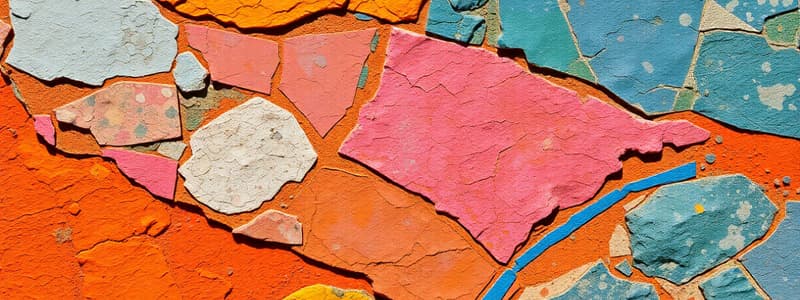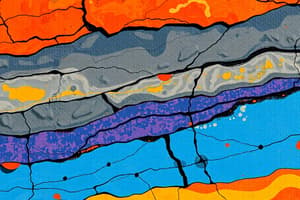Podcast
Questions and Answers
What term describes the conversion of sediment into rock?
What term describes the conversion of sediment into rock?
- Lithification (correct)
- Recrystallization
- Compaction
- Cementation
Which process involves the reduction in volume of sediments due to overlying weight?
Which process involves the reduction in volume of sediments due to overlying weight?
- Recrystallization
- Compaction (correct)
- Sedimentation
- Cementation
What is the size range for particles classified as 'Granule' in gravel?
What is the size range for particles classified as 'Granule' in gravel?
- 64 – 256 mm
- 2 - 4 mm (correct)
- 256 mm and above
- 4 – 64 mm
Which type of sedimentary rock is primarily composed of sand held together by a cementing agent?
Which type of sedimentary rock is primarily composed of sand held together by a cementing agent?
Which of these classifications refers to the arrangement of sediments based on size and shape?
Which of these classifications refers to the arrangement of sediments based on size and shape?
What types of rock are classified as mudstones, siltstones, and claystones?
What types of rock are classified as mudstones, siltstones, and claystones?
Which clastic sedimentary rock is composed of angular fragments?
Which clastic sedimentary rock is composed of angular fragments?
What is the maximum particle size for clay to be classified as claystone?
What is the maximum particle size for clay to be classified as claystone?
Flashcards are hidden until you start studying
Study Notes
Lithification
- Lithification is the process that transforms sediment into sedimentary rock.
- Compaction: The weight of overlying sediment compresses lower layers, reducing their volume.
- Cementation: Minerals precipitate between sediment grains, binding them together.
- Recrystallization: New mineral grains form within the rock.
Clastic Sedimentary Rock Classifications
- Clastic sedimentary rocks can be classified based on various characteristics.
- Grain size: Categories include:
- Gravel: Includes boulders, cobbles, pebbles, and granules.
- Sand: Ranges from coarse to very fine.
- Mud: Includes silt and clay.
- Particle roundness and sphericity: describe the shape of the grains.
- Sorting: refers to the uniformity of grain sizes.
- Matrix: The presence or absence of fine-grained material between larger grains.
Gravel Clastic Rocks
- Breccia: Composed of angular fragments of gravel.
- Conglomerate: Composed of rounded fragments of gravel.
Sand Clastic Rocks
- Sandstone: A detrital rock primarily composed of sand grains bound by cement.
- Microconglomerate: Includes small conglomerate pebbles within a sandstone matrix.
Mud Clastic Rocks
- Mudstone: Composed of a mixture of silt and clay, without layering.
- Siltstone: Composed primarily of silt, with layering.
- Claystone: Composed primarily of clay, with layering.
- Shale: Fine-grained sedimentary rock composed of silt and clay, characterized by distinct layering.
Studying That Suits You
Use AI to generate personalized quizzes and flashcards to suit your learning preferences.




